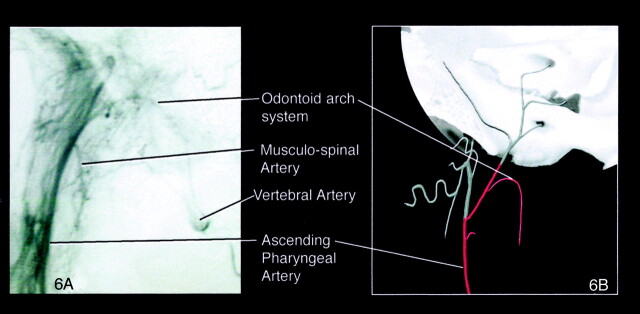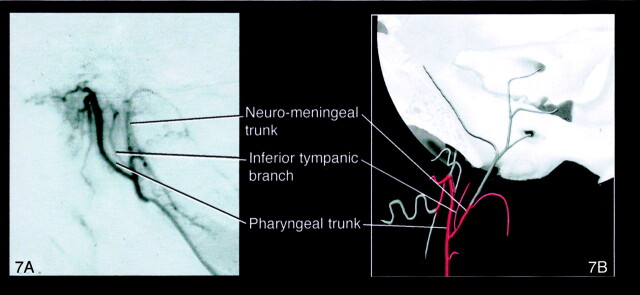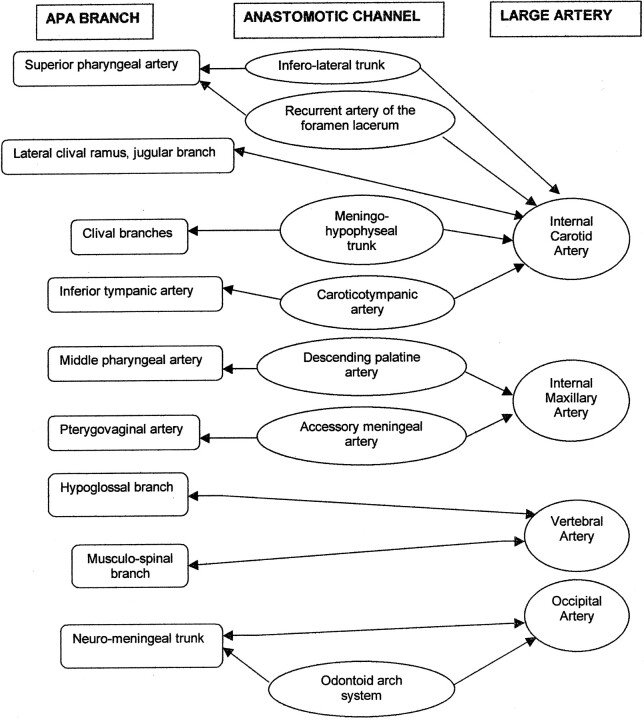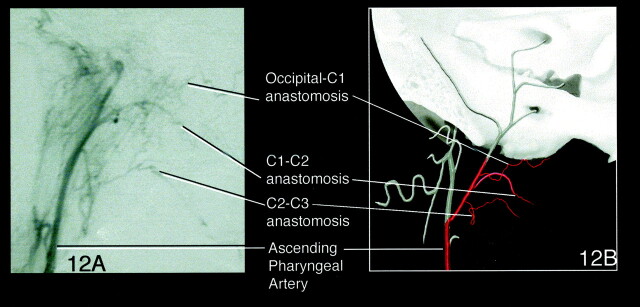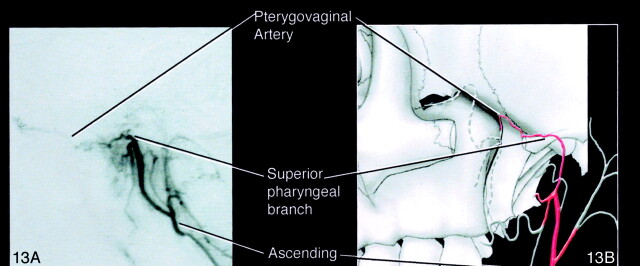Abstract
Summary: Neuroradiologists generally do not fully appreciate the importance of the territory of the ascending pharyngeal artery. The ascending pharyngeal artery is a small but important artery that supplies multiple cranial nerves and anastomotic channels to the anterior and posterior cerebral circulations. Several disease processes in the head and neck involve the ascending pharyngeal artery. To evaluate and treat such diseases, it is necessary for neuroradiologists not only to know selective angiography and embolization techniques, but also the territory of the ascending pharyngeal artery, anastomoses, and vascular supply to the vasa nervorum of lower cranial nerves. Herein, the normal angiographic anatomy of the ascending pharyngeal artery, its relationship with neighboring territories, its importance in clinical situations, and research models are reviewed.
The ascending pharyngeal artery is a small vessel. Of the 13 territories, or angiosomes, in the head and neck region, the ascending pharyngeal artery is one of three without cutaneous involvement. Selective angiography and embolization provide increasingly ready access to the ascending pharyngeal artery; however, neuroradiologists generally do not fully appreciate the clinical importance of its territory.
Normal angiographic anatomy of the ascending pharyngeal artery is reviewed. Three-dimensional renditions of the artery’s angiosome are superimposed over arterial anatomy to elucidate crucial arterial anastomoses and the supply to vasa nervorum of lower cranial nerves. The relationship of the vessel’s angiosome to neighboring territories is presented, along with potential communications with the internal and external carotid and vertebrobasilar systems.
The ascending pharyngeal artery has importance in multiple clinical situations in which interventional neuroradiology management plays a central role. Among these are trauma, epistaxis, high-grade head and neck tumors, vascular lesions, skull base tumors, subarachnoid hemorrhage, and agenetic or occluded internal carotid artery. In addition, the ascending pharyngeal artery supplies the swine “rete mirabile,” a reliable animal model for arteriovenous malformations.
Three-dimensional representation of the territory of the ascending pharyngeal artery and major anastomoses elucidate the importance of this vessel. The ascending pharyngeal artery, although small, includes several important deep-tissue extra- and intracranial structures involved in a variety of disease processes.
Anatomy
Origin
The ascending pharyngeal artery normally arises from the posterior wall of the proximal external carotid artery trunk, cephalad, and close to the source of the occipital artery (1, 2). However, the ascending pharyngeal artery may arise from the proximal occipital artery. Rare arrangements include origin from the internal carotid artery (3) (Fig 1A and B), or even from the ascending cervical artery. The latter configuration is explained by the separate origin of the ascending pharyngeal artery from the external carotid artery system in the embryo, where the ascending pharyngeal artery is part of the ventral pharyngeal territory.
Fig 1.
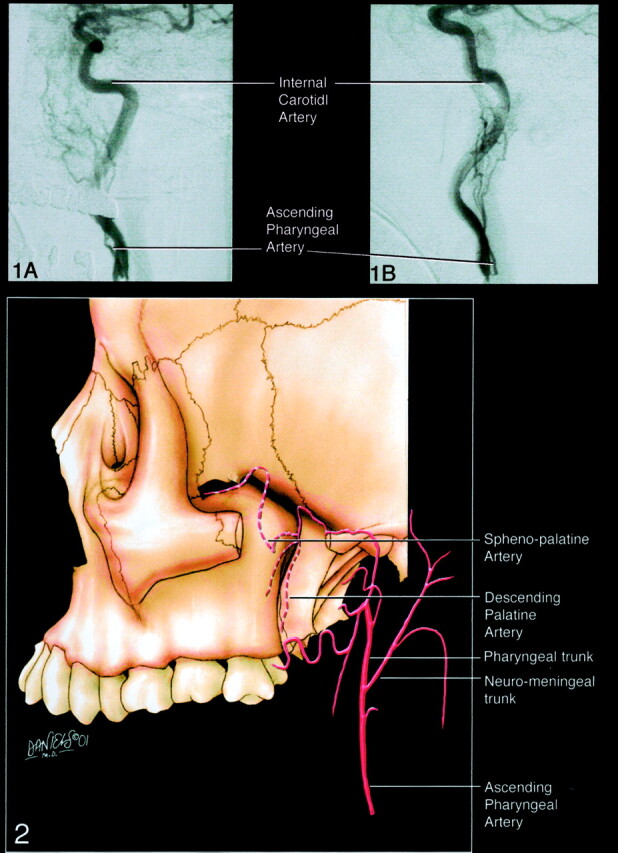
A and B, Anteroposterior (A) and lateral (B) angiograms depict rare instances of the ascending pharyngeal artery arising from the internal carotid artery.
Branches
After a short common trunk, the ascending pharyngeal artery divides into two major trunks: anteriorly, the pharyngeal trunk, which is extracranial; posteriorly, the neuromeningeal trunk, which is intracranial and enters the posterior fossa through the foramen magnum (Fig 2) (1, 2). In rare instances, the neuromeningeal trunk may arise from the occipital artery or even the posterior auricular artery. The inferior tympanic branch arises between both trunks, and thus, is described separately because of its importance. Likewise, the musculospinal artery is described separately.
Fig 2.

Diagram of the two major trunks of the ascending pharyngeal artery: anteriorly, the extracranial pharyngeal trunk; posteriorly, the neuromeningeal trunk, which is intracranial and enters the posterior fossa through the foramen magnum.
Pharyngeal Trunk.—The superior, middle, and inferior pharyngeal branches supply the pharyngeal submucosal spaces (Fig 3A and B). Abundant arterial anastomoses exist with the sphenopalatine system. A branch of the superior or middle pharyngeal artery system supplies the eustachian tube and the submucosal space of the fossa of Rosenmüller (Fig 3A and B). The superior pharyngeal artery may give rise to a carotid branch that runs along the internal carotid artery in the foramen lacerum and may anastomose with the inferolateral trunk.
Fig 3.
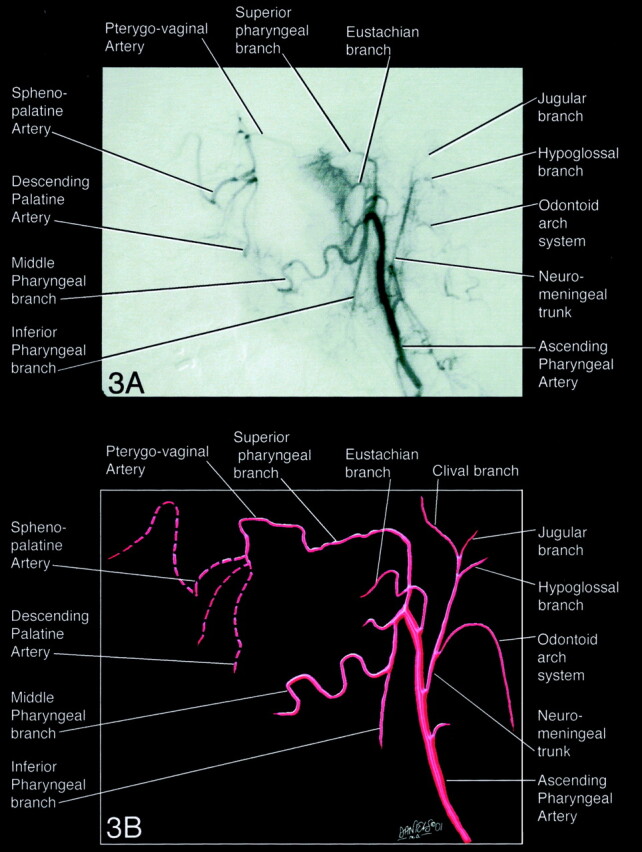
Angiogram (A) and diagram (B) of the superior, middle, and inferior pharyngeal branches supplying the pharyngeal submucosal spaces.
Neuromeningeal Trunk.—The two main divisions of the neuromeningeal trunk are the hypoglossal and jugular branches (Figs 4 and 5). The hypoglossal branch extends to the posterior fossa to the hypoglossal canal. It supplies the meninges of the posterior fossa and the vasa nervorum of cranial nerve XII. A posterior descending branch contributes to the odontoid arch system. This arterial arcade surrounds the dens and has transverse branches that anastomose with the anterior and posterior ascending arteries of the dens and is more concentrated around the neck of the odontoid (4). It also provides several branches that supply the first, second, and third cervical roots and the periosteum of the spinous processes and pedicles (Fig 6A and B). At the C2-C3 intervertebral space, it anastomoses with the vertebral artery. The jugular branch extends to the posterior fossa to the jugular foramen. It supplies the vasa nervorum of cranial nerves IX, X, and XI (5, 6). Three small branches leave the jugular foramen (Figs 4 and 5) to supply: superiorly, the meninges of the internal auditory canal; medially, the dura of the inferior petrosal sinus, and possibly, the vasa nervorum to cranial nerve VI proximal to Dorello’s canal; and laterally, the dura of the sigmoid sinus.
Fig 4.
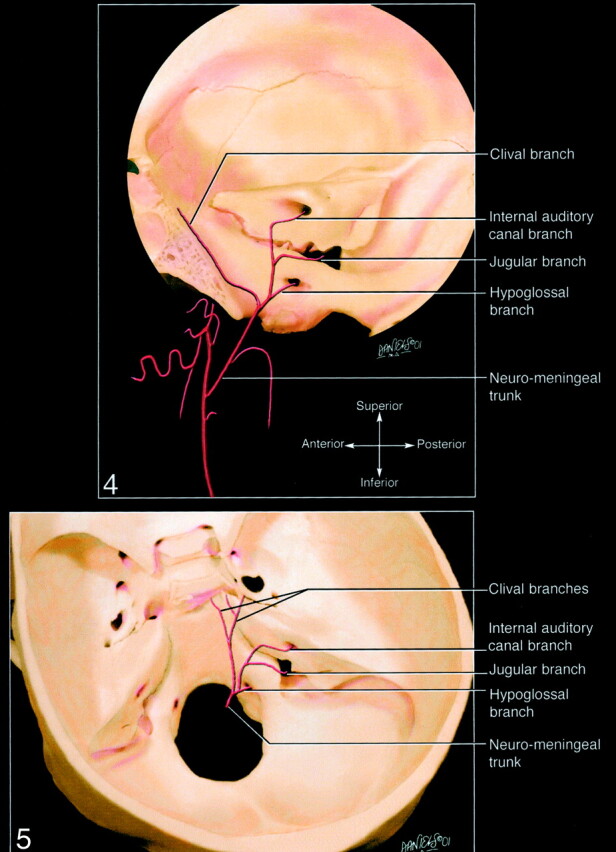
Diagram of the lateral view of the hypoglossal and jugular branches, the two main divisions of the neuromeningeal trunk. Top, superior view; bottom, inferior view; left, anterior view; right, posterior view.
Fig 5.

View from above the hypoglossal and jugular branches. Top, superior view; bottom, inferior view; left, anterior view; right, posterior view.
Fig 6.
Angiogram (A) and diagram (B) of the odontoid arch system that gives rise to several branches that supply the first, second and third cervical roots and the periosteum of the spinous processes and pedicles. Top, superior view; bottom, inferior view; left, anterior view; right, posterior view.
Inferior Tympanic Branch
The inferior tympanic artery most commonly arises from the proximal aspect of the neuromeningeal trunk but can arise as a separate branch between the pharyngeal and neuromeningeal trunks (Fig 7A and B). It is close to cranial nerve IX and provides rami to the caroticotympanic branch of the internal carotid artery, the vasa nervorum of cranial nerve XI, and the vasa vasorum of the internal carotid artery. It also provides an anastomotic branch to the petrosquamosal branch of the middle meningeal artery and an anastomotic branch to the stylomastoid artery, which may supply the vasa nervorum to the facial nerve.
Fig 7.
Angiogram (A) and diagram (B) of the inferior tympanic artery arising as a separate branch between the pharyngeal and neuropharyngeal trunks. Top, superior view; bottom, inferior view; left, anterior view; right, posterior view.
Musculospinal Artery
The musculospinal artery anastomoses with the vertebral artery at the level of the third intervertebral space (C2-C3) (Fig 6A and B). It also anastomoses with the most superior branch of the ascending cervical artery at C3 and with the deep cervical artery. It may supply the vasa nervorum to cranial nerve XI and the superior sympathetic ganglion.
Anastomoses to Major Arteries
The ascending pharyngeal artery has potential anastomoses to all neighboring major arteries (Table and Fig 8). Anastomoses to the internal carotid artery are either direct via the lateral clival branch of the jugular artery or the recurrent artery of the foramen lacerum, or indirect, via the superior pharyngeal branch to the inferolateral trunk, the clival branches to the meningohypophyseal trunk (Fig 9A and B), or the inferior tympanic branch to the caroticotympanic branch. Anastomoses to the vertebral artery are through the hypoglossal branch and the musculospinal branch (Fig 10A and B). Anastomoses to the occipital artery can be either indirect through the odontoid arch system (Fig 11A and B) or direct through a common trunk (Fig 12A and B). Lastly, the ascending pharyngeal artery is connected to the internal maxillary artery at the level of the descending palatine artery through the middle pharyngeal branch (Fig 3A and B) or the pterygovaginal artery to the accessory meningeal artery (Fig 13A and B).
TABLE 1:
Ascending pharyngeal artery anastomoses and foramina
| Branch | Foramen | Anastomoses |
|---|---|---|
| Middle pharyngeal artery | Descending palatine artery (IMA) | |
| Accessory meningeal artery (IMA) | ||
| Superior pharyngeal artery | Foramen lacerum | Inferolateral trunk to ICA |
| Clival branches to meningohypophyseal trunk to ICA | ||
| Pterygovaginal canal | Pterygovaginal artery to accessory meningeal artery (IMA) | |
| Foramen lacerum | Recurrent artery of the foramen lacerum to ICA | |
| Inferior tympanic artery | Petrosquamosal branch of middle meningeal artery | |
| Caroticotympanic artery to ICA | ||
| Stylomastoid artery | ||
| Hypoglossal branch | Hypoglossal canal | Vertebral artery |
| Jugular branch | Jugular foramen | Lateral clival artery to ICA |
| Musculospinal branch | Foramen magnum | Vertebral artery |
| Odontoid arch system | Foramen magnum | Occipital artery |
Note.—IMA signifies internal maxillary artery; ICA, internal carotid artery.
Fig 8.
Diagram depicting ascending pharyngeal artery anastomoses.
Fig 9.
Angiogram (A) and diagram (B) of the ascending pharyngeal artery communication with the internal carotid artery to the lateral clival branch of the jugular artery.
Fig 10.
Angiogram (A) and diagram (B) of the ascending pharyngeal artery anastomoses to the vertebral artery via the hypoglossal branch and musculospinal branch. Top, superior view; bottom, inferior view; left, anterior view; right, posterior view.
Fig 11.
Angiogram (A) and diagram (B) of anastomoses to the occipital artery via the odontoid arch. Top, superior view; bottom, inferior view; left, anterior view; right, posterior view.
Fig 12.
Angiogram (A) and diagram (B) of C1-C2 anastomoses to the occipital artery via the common trunk. Top, superior view; bottom, inferior view; left, anterior view; right, posterior view.
Fig 13.
Angiogram (A) and diagram (B) of anastomoses via the pterygovaginal artery to the accessory meningeal artery. Top, superior view; bottom, inferior view; left, anterior view; right, posterior view.
Territory
Taylor and Palmer (7, 8) developed the concept of the angiosome, or vascular territory, in the late 1980s. These authors performed a rigorous dissection of tissue layers, including the skin, musculoaponeurotic system, muscles, bone, dura, and brain. Each layer was labeled and mapped to its respective arterial and venous contributors. Then the data were computer analyzed with color coding and three-dimensional reconstruction (7). In most cases, the territory of a superficial artery originating in the skin included the adjacent deep tissues, which generated the angiosome concept. Arteries were noted to closely follow the connective tissue framework. Direct cutaneous arteries of varying caliber, length, and attenuation are responsible for the skin supply in a given territory. In addition to this primary supply, numerous small indirect vessels reinforce the superficial vasculature before the main arteries penetrate to supply the deep tissues (8).
Thirteen angiosomes were defined in the head and neck region. These derive their supply from branches of the external carotid, internal carotid, and subclavian arteries, and their three-dimensional territories encompass skin, deep soft tissue, and bone. Only three of these angiosomes were noted to have no cutaneous involvement, containing only deep tissues. They were supplied by the ascending pharyngeal artery, the lingual artery, and the vertebral artery (7).
Clinical Relevance of the Ascending Pharyngeal Artery
Trauma
The ascending pharyngeal artery plays an important role in the healing process of Le Fort I osteotomies, because it supplies the attached posterior palatal soft-tissue pedicle. Le Fort osteotomies, as well as the fractures themselves, disrupt the pterygomaxillary junction by interrupting the descending palatine branches of the internal maxillary artery. Although an abundant mucosal alveolar anastomotic network in the maxilla remains, and the ascending palatine branch of the facial artery may be uninterrupted, much of the healing process is achieved by means of the ascending pharyngeal artery (9). In the same fashion, the ascending pharyngeal artery is directly involved in the closure of cleft palates (10).
Epistaxis
Embolization plays an increasing role in the management of epistaxis. Most commonly, the distal internal maxillary artery is the target vessel; less commonly, the facial artery serves as the site. Rarely is the ascending pharyngeal artery the only or a major source of severe epistaxis, requiring superselective embolization for successful control (11, 12).
High-Grade Head and Neck Tumors
Intraarterial embolization is proving to be useful for treating recurrent or high-grade head and neck cancers (13). Superselective microcatheter placement in various branches of the external carotid artery system is necessary for effective treatment. Specifically, superselective infusion of the ascending pharyngeal artery is necessary for successful embolization of cancer of the palate (13, 14).
Vascular Lesions
At the skull base, arteriovenous malformations and arteriovenous fistulas are uncommon but pose serious therapeutic challenges. Owing to its central position, the ascending pharyngeal artery can be a major feeder to arteriovenous fistulas (15) or arteriovenous malformations (16, 17).
Skull Base Tumors
Predictably, the ascending pharyngeal artery is the primary source of supply to meningiomas (Fig 13A and B) and glomus jugulare and tympanicum tumors (2) (Fig 14A and B) of the jugular foramen region. Giant cell tumors (18), hemangiopericytomas, and extramedullary plasmacytomas can occur in the jugular foramen, mimic glomus jugulare tumors in all aspects of their clinical and radiographic presentation (19), and derive their supply from the ascending pharyngeal artery. The ascending pharyngeal artery is even the primary vascular supply of the rare primary adenomatous tumor of the middle ear (20).
Fig 14.
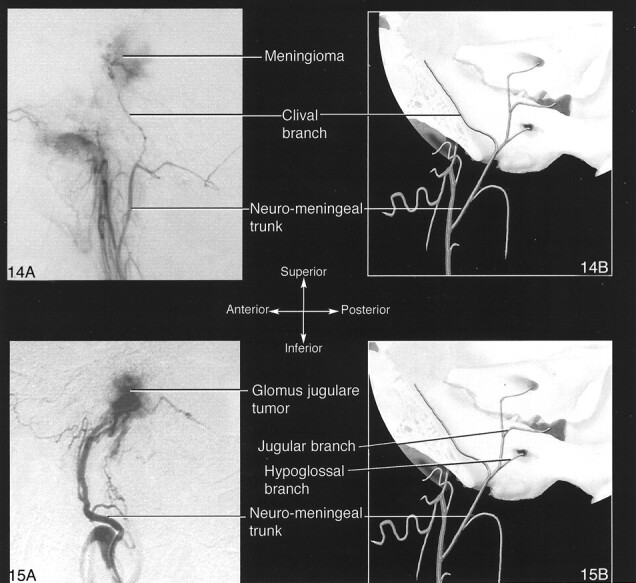
Angiogram (A) and diagram (B) of the ascending pharyngeal artery supplying a meningioma. Top, superior view; bottom, inferior view; left, anterior view; right, posterior view.
Subarachnoid Hemorrhage
Subarachnoid hemorrhage from rupture of a saccular aneurysm of the posterior clival meningeal branch of the ascending pharyngeal artery has been reported (21).
Collaterals to Agenetic or Occluded Internal Carotid Artery
The ascending pharyngeal artery can function as collaterals to an agenetic internal carotid artery (22), in which case the most common configuration is replacement of the petrous segment with an intratympanic ascending pharyngeal artery loop. The ascending pharyngeal artery can also be recruited in case of an occluded internal carotid artery (23). Persistent collateral circulation with the distal carotid artery at the skull base has been described and shown to be a potential source of emboli into the retinal or intracranial territories (24).
Neurovascular Research Models
Because it has vascular characteristics likened to those of an arteriovenous malformation nidus, the swine rete mirabile has been proposed as a model to study the kinetics of liquid embolic agents (25, 26). The ascending pharyngeal artery supplies the rete mirabile.
Conclusion
The ascending pharyngeal artery, although small, is an important vessel with a territory that includes several deep extra- and intracranial structures involved in a variety of disease processes. A three-dimensional representation of the vessel’s territory and major anatomoses may help the reader to better appreciate these points.
Fig 15.

Angiogram (A) and diagram (B) of the ascending pharyngeal artery supplying a glomus jugulare tumor. Top, superior view; bottom, inferior view; left, anterior view; right, posterior view.
Acknowledgments
The authors are indebted to Cathy Marszalkowski for expert assistance in editing this work.
References
- 1.Lasjaunias P, Moret J The ascending pharyngeal artery: normal and pathological radioanatomy. Neuroradiology 1976;11:77–82 [DOI] [PubMed] [Google Scholar]
- 2.Lasjaunias P, Berenstein A. Surgical Neuroangiography, Vol 1: Functional Anatomy of Craniofacial Arteries. Berlin-Heidelberg: Springer-Verlag;1986. :123–154
- 3.Kaneko K, Akita M, Murata E, Imai M, Sowa K. Unilateral anomalous left common carotid artery; a case report. Anat Anz 1996;178:477–480 [DOI] [PubMed] [Google Scholar]
- 4.Haffajee MR. A contribution by the ascending pharyngeal artery to the arterial supply of the odontoid process of the axis vertebra. Clin Anat 1997;10:14–18 [DOI] [PubMed] [Google Scholar]
- 5.Lasjaunias P, Doyon D. The ascending pharyngeal artery and the blood supply of the lower cranial nerves. J Neuroradiol 1978;5:287–301 [PubMed] [Google Scholar]
- 6.Lapresle J, Lasjaunias P. Cranial nerve ischaemic arterial syndromes: a review. Brain 1986;109:207–216 [DOI] [PubMed] [Google Scholar]
- 7.Taylor GI, Palmer JH. Angiosome theory. Br J Plast Surg 1992;45:327–328 [DOI] [PubMed] [Google Scholar]
- 8.Taylor GI, Palmer JH. The vascular territories (angiosomes) of the body: experimental study and clinical applications. Br J Plast Surg 1987;40:113–141 [DOI] [PubMed] [Google Scholar]
- 9.Siebert JW, Angrigiani C, McCarthy JG, Longaker MT. Blood supply of the Le Fort I maxillary segment: an anatomic study. Plast Reconstr Surg 1997;100:843–851 [DOI] [PubMed] [Google Scholar]
- 10.Mercer NS, MacCarthy P. The arterial supply of the palate: implications for closure of cleft palates. Plast Reconstr Surg 1995;96:1038–1044 [DOI] [PubMed] [Google Scholar]
- 11.Hacein-Bey L, Rosenbloom JS, Pile-Spellman J, et al. Anastomoses in recurrent epistaxis. J Vasc Interv Radiol 1997;8:535–538 [DOI] [PubMed] [Google Scholar]
- 12.Kurata A, Kitahara T, Miyasaka Y, Ohwada T, Yada K, Kan S. Superselective embolization for severe traumatic epistaxis caused by fracture of the skull base. AJNR Am J Neuroradiol 1993;14:343–345 [PMC free article] [PubMed] [Google Scholar]
- 13.Robbins KT, Fontanesi J, Wong FS, et al. A novel organ preservation protocol for advanced carcinoma of the larynx and pharynx. Arch Otolaryngol Head Neck Surg 1996;122:853–857 [DOI] [PubMed] [Google Scholar]
- 14.Imai S, Kajihara Y, Munemori O, et al. Superselective cisplatin (CDDP)-carboplatin (CBDCA) combined infusion for head and neck cancers. Eur J Radiol 1995;21:94–99 [DOI] [PubMed] [Google Scholar]
- 15.Guglielmi G, Guidetti G, Mori S, Silipo P. Therapeutic embolization of an ascending pharyngeal artery-internal jugular vein fistula: case report. J Neurosurg 1988;69:132–133 [DOI] [PubMed] [Google Scholar]
- 16.Nakahara I, Pile-Spellman J, Hacein-Bey L, Crowell RM, Gress D. [Posterior fossa dural arteriovenous fistula with isolated sinus segment]. No To Shinkei 1993;45:703–709 [PubMed] [Google Scholar]
- 17.Tsukada K, Yoshioka A, Kawada J, Takado M, Hirose G. [A case report of a patient with an arterio-venous malformation in the cisterna magna supplied by bilateral ascending pharyngeal arteries]. Rinsho Shinkeigaku 1988;28:1241–1245 [PubMed] [Google Scholar]
- 18.Rosenbloom JS, Storper IS, Aviv JE, Hacein-Bey L, Bruce JN. Giant cell tumors of the jugular foramen. Am J Otolaryngol 1999;20:176–179 [DOI] [PubMed] [Google Scholar]
- 19.Megerian CA, McKenna MJ, Nadol JB, Jr. Non-paraganglioma jugular foramen lesions masquerading as glomus jugulare tumors. Am J Otol 1995;16:94–98 [PubMed] [Google Scholar]
- 20.Kuroiwa T, Moriwaki K, Nagasawa S, Ohta T, Tsutsumi A, Tanabe H. [Primary adenomatous tumor of the middle ear: a case report]. No Shinkei Geka 1993;21:463–466 [PubMed] [Google Scholar]
- 21.Mujica PH, Rosemblat AM, Luessenhop AJ. Subarachnoid hemorrhage secondary to an aneurysm of the ascending pharyngeal artery: case report. J Neurosurg 1981;54:818–820 [DOI] [PubMed] [Google Scholar]
- 22.Meder JF, Blustajn J, Trystram D, et al. Radiologic anatomy of segmental agenesis of the internal carotid artery. Surg Radiol Anat 1997;19:385–394 [DOI] [PubMed] [Google Scholar]
- 23.Bruckmann H, Zeumer H, Ferbert A. “Distal stump” of the internal carotid artery with ascending pharyngeal artery collateralisation: a potential source for further embolic ischemia. Neuroradiology 1987;29:81–83 [DOI] [PubMed] [Google Scholar]
- 24.Pelz DM, Fox AJ, Vinuela F, Dion JE, Agnoli L. The ascending pharyngeal artery: a collateral pathway in complete occlusion of the internal carotid artery. AJNR Am J Neuroradiol 1987;8:177–178 [PMC free article] [PubMed] [Google Scholar]
- 25.Massoud TF, Ji C, Viñuela F, Guglielmi G, et al. An experimental arteriovenous malformation model in swine: anatomic basis and construction technique. AJNR Am J Neuroradiol 1994;15:1537–1545 [PMC free article] [PubMed] [Google Scholar]
- 26.Siekmann R, Wakhloo AK, Lieber BB, Gounis MJ, Divani AA, Hopkins LN. Modification of a previously described arteriovenous malformation model in the swine: endovascular and combined surgical/endovascular construction and hemodynamics. AJNR Am J Neuroradiol 2000;21:1722–1725 [PMC free article] [PubMed] [Google Scholar]



